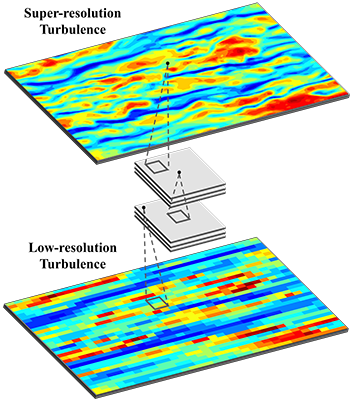Super-Resolution Reconstruction of Turbulence
We present an unsupervised learning model based on a cycle-consistent generative adversarial network (CycleGAN)
that can be trained with unpaired turbulence data for super-resolution reconstruction.
Our model successfully reconstructs the high-resolution flow field of statistically DNS quality from the LES data.
Furthermore, we find that the present model has almost universal applicability to all values of Reynolds number within the tested range.

Prediction of 2D Turbulence Using Deep Learning
Prediction of turbulence has important implications in various applications such as flow control and turbulence modeling. Here, the prediction of 2D decaying homogeneous isotropic turbulence has been conducted using deep learning. We trained one of the latest network models, called conditional Generative Adversarial Networks (cGANs), using datasets produced by direct numerical simulation to capture the correlation between the input and output. By assessing the prediction accuracy for various prediction time span, we confirmed that a satisfactory level of prediction can be achieved for a time span of the integral time scale.
High Fidelity Indoor Dispersion Analysis Using LES/IBM
Indoor flow and contaminant dispersion are predicted using LES coupled with immersed boundary method. Contaminant transport by infiltration or leakage flow needs to be analyzed to respond to accidental releases of chemical or biological agent. Indoor environments which consist of various objects are efficiently implemented in simulation using IBM. For real-time prediction of flow and dispersion in the indoor environment all these implementations are conducted on GPU system.
Simulation of the Mushroom Cloud Generated from a High-Energy Explosion
We performed numerical simulations of flow caused by a 20 kT heavy explosion to predict the rise and diffusion of a mushroom cloud after the atmospheric pressure is recovered around the burst point. We proposed a new formulation of governing equations based on the anelastic approximation and density weighted variables to implement the atmospheric stratification by employing potential temperature to account for the effect of atmospheric pressure variation along the altitude.
Simulation of Settling Ellipsoidal Particles in Isotropic Turbulence
We examine the behavior of settling ellipsoidal particles which model more realistic particles found in natural environment than the spherical particles used in many previous studies. We propose a new formulation for the evolution equation of a spheroidal particle. When rod or disk-like particles were suspended in the turbulent flow, it was confirmed that the behavior of particle clustering is different from that of the sphere, and that there is clear correlation between the orientation of the spheroidal particles and the Lagrangian stretching directions.
Particle-laden Rayleigh-Bénard Convection
Rayleigh-Bérnard convection laden with particles or bubbles is often found in many natural phenomena but not well studied. Using the point-particle or bubble approximation we investigate the interaction between particles or bubble and the background turbulence using direct numerical simulations. Interestingly, as the settling particles interact with the fluid, they induce strong interaction between turbulence and plumes, creating large-scale polygonal cells, a typical characteristic of RB convection.
Path Instability of a Spheroidal Bubble in Turbulence
Path instability of a millimetric spheroidal bubble in quiescent fluid and in isotropic turbulence is investigated by direct numerical simulation. An immersed boundary method along with a new formulation of the equation of bubble motion is utilized to impose the no-slip condition on the surface of an air bubble in fixed shape with the equivalent diameter of 1.0 ~ 4.0mm in contaminated water. The effect of background turbulence on path instability of a rising bubble, which typically shows zigzag pattern in still fluid, is investigated.
Modification of Turbulence by Finite-Size Particles in Stratified Channel Turbulence
Direct numerical simulations are carried out for thermally stratified turbulent channel flow laden with finite-size particles using an immersed boundary method that was developed for use in nonuniform grids. We find that neutrally buoyant particles make the internal gravity waves stronger. The vertical motion of the particles is limited to each half of the channel due to the gravity wave, which acts as a wall at the center of the channel. If the particles are slightly heavier than the fluid, the turbulence structures are greatly modified by the particles. Analysis of the vortex structure with the heat flux shows that the particles play a role in suppressing the vertical heat transport.